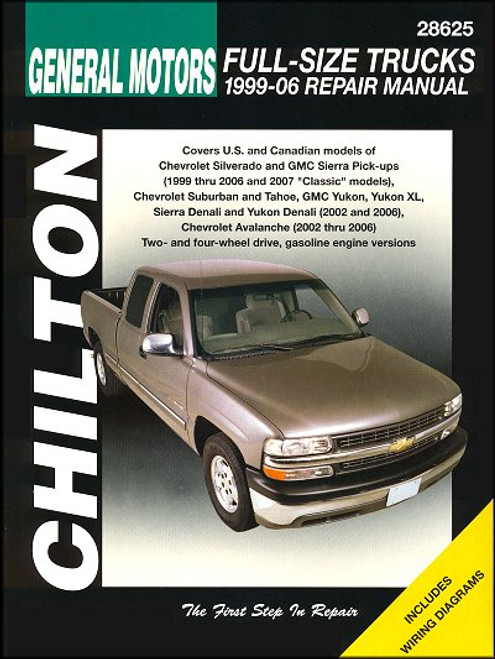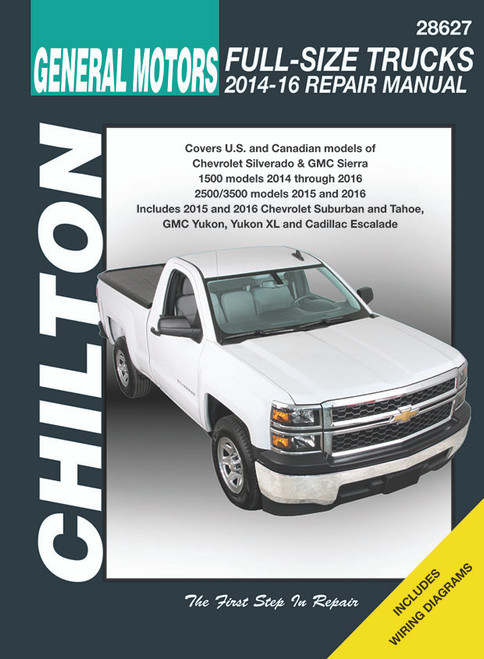This Chilton 28626 repair and service manual covers 2007-2013 Chevy and GMC full-size trucks and SUVs built on 1500, 2500 and 3500 platforms, 2WD and 4WD. It's the perfect tool for the do-it-yourselfer. You'll love all of the step-by-step instructions, detailed specifications, photographs and exploded views. From small repairs to major service, this book has you covered.
NOTE: Does NOT include 2007 Silverado Classic, Sierra Classic or Sierra Denali Classic, or information specific to diesel engine models, CNG models, hybrids or models equipped with rear-wheel steering.
These popular vehicles are powered by 4.3L V6 and 4.8L, 5.3L, 6.0L and 6.2L V8 gasoline engines, all equipped with sequential multi-port fuel injection systems.
Power is transmitted to the rear wheels via a 4-speed or 6-speed automatic transmission.
Models covered by this manual include: PICKUP TRUCKS
- Chevy Silverado
- GMC Sierra
- GMC Sierra Denali
- Chevy Suburban
- Chevy Tahoe
- Chevy Avalanche
- GMC Yukon
- GMC Yukon XL
- GMC Yukon Denali
Book Excerpt: 2007-2014 Chevy Silverado, Suburban, Tahoe, Avalanche, GMC Sierra, Yukon, Yukon XL, Denali Repair Manual V8 ENGINES
GENERAL INFORMATION This Part of Chapter 2 is devoted to in-vehicle repair procedures for the 4.8L, 5.3L, 6.0L and 6.2L V8 engines. These engines utilize either aluminum or cast-iron blocks with eight cylinders arranged in a "V" shape at a 90-degree angle between the two banks. The cylinder heads utilize an overhead valve arrangement. Engines with aluminum cylinder heads use pressed-in valve guides and valve seats, while engines with cast iron cylinder heads have integral valve guides and hardened valve seats. Hydraulic roller lifters actuate the valves through tubular pushrods and rocker arms. The oil pump is mounted at the front of the engine behind the timing chain cover and is driven by the crankshaft. To positively identify these engines, locate the Vehicle Identification Number (VIN) on the left front corner of the instrument panel. The VIN is visible from the outside of the vehicle through the windshield. The eighth character in the sequence is the engine designation:Information concerning engine removal and installation and engine overhaul can be found in Part C of this Chapter. The following repair procedures are based on the assumption that the engine is installed in the vehicle. If the engine has been removed from the vehicle and mounted on a stand, many of the steps outlined in this Part of Chapter 2 will not apply.
- C = 4.8L V8 engine
- M, 0, 3, J = 5.3L V8 engine
- K, Y = 6.0L V8 engine
- 8 = 6.2L V8 engine
AXLES: DESCRIPTION AND CHECK
- DESCRIPTION
- The rear axle assembly is a hypoid (the centerline of the pinion gear is below the centerline of the ring gear), semi-floating type. When the vehicle goes around a corner, the differential allows the outer rear wheel to turn at a higher speed than the inner tire. The axleshafts are splined to the differential side gears, so when the vehicle goes around a corner, the inner wheel, which turns more slowly than the outer wheel, turns its side gear more slowly than the outer wheel turns its side gear. The differential pinion gears roll around the slower side gear, driving the outer side gear (and tire) more quickly.
- An optional locking limited-slip rear axle is also available. This differential allows for normal operation until one wheel loses traction. A limited-slip unit is similar in design to a conventional differential, except for the addition of a pair of multi-disc clutch packs which slow the rotation of the differential case when one wheel is on a firm surface and the other on a slippery one. The difference in wheel rotational speed produced by this condition applies additional force to the pinion gears and through the cone, which is splined to the axleshafts, equalizes the rotation speed of the axleshaft driving the wheel with traction.
- On 4WD models, a fully independent front axle assembly is used. This consists of a differential and a pair of driveaxles. Each driveaxle has an inner and outer constant velocity (CV) joint. Because the differential - like the transfer case - is offset to the left, the distance between the differential and the right front wheel is greater than the distance from the differential to the left wheel. In order to use two equal-length driveaxles, an extension axleshaft is employed on the right side to make up the difference. CHECK
- Often, a suspected axle problem lies elsewhere. Do a thorough check of other possible causes before assuming the axle is the problem.
Subject: 2007, 2008, 2009, 2010, 2011, 2012, 2013, 2014 Chevy Silverado, Suburban, Tahoe, Avalanche, GMC Sierra, Yukon, Yukon XL, Denali service, maintenance, and repair instructions. ISBN-10: 1620923068 | ISBN-13: 9781620923061| Chilton 28626
Introduction: About this manual | Introduction | Vehicle identification numbers | Maintenance techniques, tools and working facilities | Buying parts | Jacking and towing | Booster battery (jump) starting | Conversion factors | Automotive chemicals and lubricants | Safety first! | Troubleshooting
- Tune-up and routine maintenance
- 4.3L V6 engine
- 4.8L V8 engine
- 5.3L V8 engine
- 6.0L V8 engine
- 6.2L V8 engine
- General engine overhaul procedures
- Cooling, heating and air-conditioning systems
- Fuel and exhaust systems
- Engine electrical systems
- Emissions and engine control systems
- Automatic transmission
- Transfer case
- Driveline
- Brakes
- Suspension and steering systems
- Body
- Chassis electrical system
- Wiring diagrams











